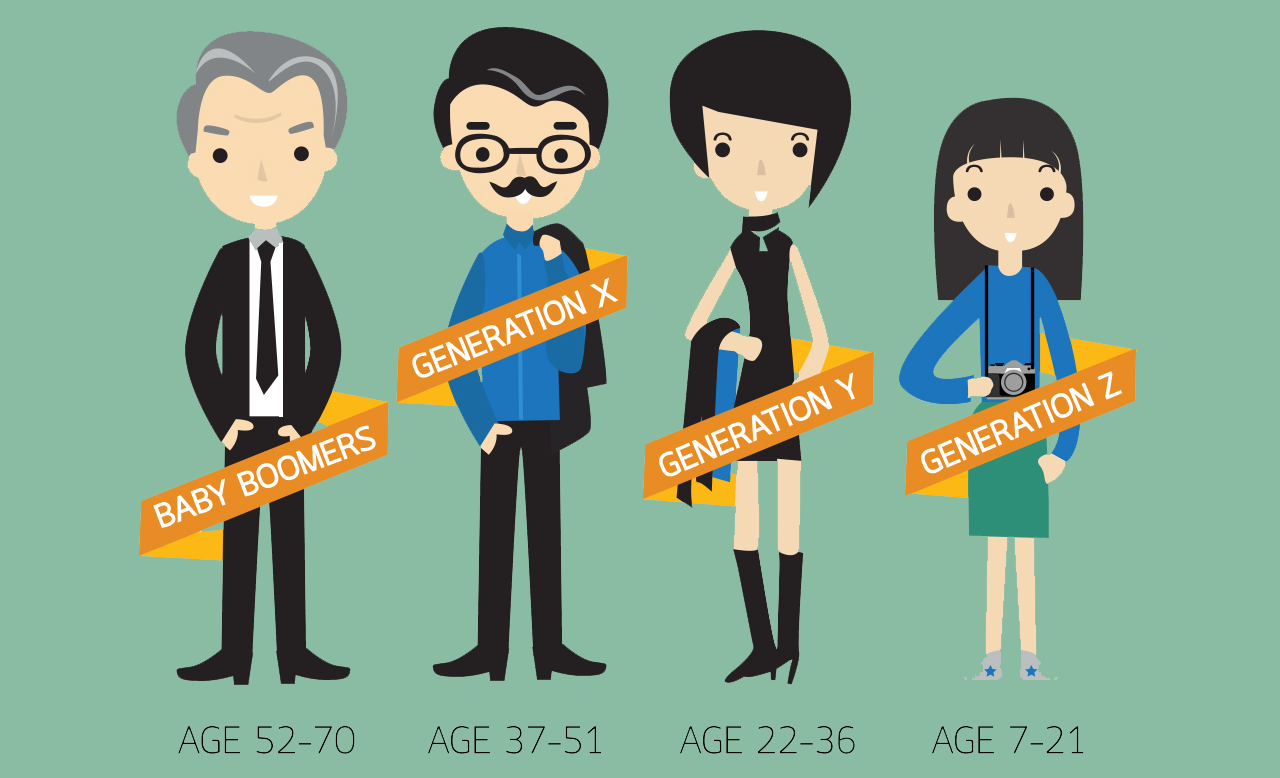We talked a few articles ago about the Project Manager and how the management of the project teams should function, not considering the generational difference.
We have described, in that article, how today, in a job or in a team, up to 5 generations can be co-present, and this aspect must be managed at best if a project has to be successfully concluded.
Developing and mastering the generational skills within your work team is therefore essential for the project manager. Thanks to it, it will be possible to better understand the behaviors (“what” the team members do), and clarify the convictions and basic attitudes (“why” the team members do it).
As a result, project managers will improve leadership, time management and communication in order to foster respect and maximum productivity among team members.
CONTENT INDEX
- How to overcome the generational differences of the work team
- Leadership: hierarchy and authority through the generations
- Strategic time management and priorities: work and personal time in all generations
- Communicate with the multigenerational work team: communication styles
- Some strategies for communicating with multigenerational work teams
- Strategy n. 1: Do your research
- Strategy n. 2: be ready to embrace change
- Strategy n. 3: Develop your “generational competence”
- Strategy n. 4: focus on being relevant
How to overcome the generational differences of the work team
According to industry experts, the so-called generational gap is, in large part, the result of misunderstandings fueled by common insecurities and the desire for influence.
In an integration process, three relevant areas have been identified for project managers who wish to develop their generational competence and reduce this gap.
- Leadership (hierarchy and authority between generations),
- Time management (personal and work time between generations)
- Communication (favorite styles across generations)
Leadership: hierarchy and authority through the generations
The teams that work on a project are never homogeneous both for age as well as for culture and life experiences.
Therefore, in order to affirm one’s leadership, it is fundamental to understand where a generation tends to see the hierarchy and the authority. By hierarchy and authority we mean the whole package, including the way the rules are set, the way teamwork is displayed, and how management styles vary.
It will be appropriate, therefore, to make a roundup on the characteristics of the various generations in order to understand them more thoroughly.

Loyalty and respect are a common denominator for Millenials (Generation Y). The Millenial is faithful to people, respects and seeks the guidance of those who hold positions of authority.
It is important to involve this generation, to really give them a “seat at the table” and to seriously consider their ideas, their creativity and the innovation they offer.
Of course, this can go against corporate hierarchical systems, but it is good to think that, despite their young age, in many workplaces they are no longer the younger generation, or if they are, they will soon pass that role to the Generation Z.
The Baby Boomers, on the other hand, support teamwork and fairness, but think that the rules can be challenged. It is important to be prepared to clarify the reasons for the proposed changes, since it is a generation that easily questions authority.
Due to the propensity of this generation, it can also be strategic and effective to ask them to guide new employees in the organization.
Many people belonging to the Generation Y are sons of Boomers and for this reason there is a high level of synergy and understanding between the new “younger” generations and the “younger” generations in the workplace.
Generation X, on the contrary, believes that the rules are dynamic and established by individuals rather than by institutions. They tend to test authority and do not like too much supervision or micromanagement. This generation of individuals is often guided better by exploiting their independent and entrepreneurial instincts. The best way to value this generation is based on new ways and individual approaches towards things.
Strategic time management and priorities: work and personal time in all generations
In a spectrum of time management, we need to consider the different priorities in terms of work-life balance and related obligations.
The Baby Boomers consider work as a high priority. If involved, they commit their work hours to projects, regardless of productivity.
This is a generation that has invented the concept of the workaholic and strongly believes in visibility in the workplace.
Generally speaking, it is a generation which is reluctant to take a break and lose the so-called “place in the team”, resulting, for many, in a state of imbalance between work and family.
Many strategies to work effectively with Baby Boomers are focused on recognizing the time spent on projects. A public recognition of their work, in addition to benefits based on financial criteria (for example, expense accounts, travel), more flexible working hours, and interactions with the highest roles of the company, help motivate them and communicate the value attributed to their work.
Generation X, on the other hand, is characterized by the desire to control and set up one’s career path, personal ambitions, time and place of work. It is paid to do a job, but has also time for other areas of life.
Many individuals of this generation is still rebellious against Boomer parents who have never found this balance between private and professional life.
Generation X shows much more than a “work to live mentality” and sacrifices balance when necessary, but not as a general rule.
The best X Generation management best practices indicate that you focus on your business while leaving the greatest possible time management freedom. At the micro level, this can take the form of allowing them to work alone or reward them with a price in form of free time for a job well done.
At the macro level, it is possible to provide them with options to control their professional development path. Prizes and awards should not be visible – like in the case of Boomers – and should focus on the results of the project, rather than the time spent on a project or even an organization.
The Millennials generation is driven by a strong need for work-life balance and benefits that enable a rewarding career and life, including personal development and community involvement.
For this generation, lifestyle and meaningful experience count and they are looking for an organization that allows both.
It is important to recognize the Mllennials’ desire for frequent and ascendant change, and organizations can do so by offering a variety of career paths in project management and exposure to a myriad of project experiences.
Communicate with the multigenerational work team: communication styles
In a communication approach, we need to be aware of what types of communication are most appreciated by each group and how they are used.
Baby Boomers believe a lot in face-time, that is in the interpersonal relationship, although they often like a written follow-up.
It is important to understand that this “workaholic” generation often expects more than anything, and this includes not only the hours, but also the follow-through, the project documentation and the organization. Although they are almost at the top of the organization considering the age, their technological capabilities should not be underestimated.
Generation X and Millennials both have a lower value in terms of face time, having grown with much greater technological influences than the Baby Boomers.
Generation X tends to look for open communication regardless of organizational hierarchy and status. This techno-literate generation often uses e-mail as the primary method of communication, preferring to keep short messages. It is a generation that appreciates giving and receiving regular feedback.
Millennials like communications anytime, anywhere and can be described as techno-savvy (techno-experts).
It is the first generation that needs to be connected 24 hours a day, 7 days a week. It is a generation that requires real-time communication as text, chat, Twitter.
What at first sight may seem like a distraction is often their way of working and doing multitasking. Technological social networks have also translated into a more natural ability to work in teams, interact with different people and connect between different cultures. This generation seeks positive reinforcements from superiors and respects their opinions.
Some strategies for communicating with multigenerational work teams
In addition to specific strategies for the already mentioned generations, it is good to always have a general overview, an alternative point of view.
For this reason, we want to provide you with some strategies for the leadership of successful multigenerational projects:
Strategy n. 1: Do your research
Although we often think of generations in terms of age, as we have seen, each generation is defined much more by common experiences than by birth years. So, just like you would do with a national culture, do your research.
Understanding the key factors and events that have shaped the group’s behavior in each country will help you understand more and judge less. Do not create stereotypes based on age. Age is just a number.
Strategy n. 2: be ready to embrace change
In the last ten years, the US labor force has changed dramatically. The generation of Baby Boomers has shrunk from 18% to 2% and Gen X and Millennials have come to dominate the workforce with a percentage of 64%.
As a leader in high-performance organizations, we need to be aware of both the current generation situation in the countries we are working in and changes in the horizon. Being ready to embrace change, we need improve our ability to conduct effectively.
Strategy n. 3: Develop your “generational competence”
Through our educational and professional efforts, we focus on skills development. Demonstrating “cultural competence” has become popular, but have you thought about management changes that you can make to show “generational competence”? For example, in general, the Chinese Millennials are motivated by a tough work, while European Millennials often seek work-life balance, and US Millennials seek work that offers personal satisfaction, taking into account differences like these is now a critical part of achieving organizational success on a global scale.
Strategy n. 4: focus on being relevant
Rather than equating “different” with “bad”, today’s leaders should think more about how to be relevant. As we modify our products and strategies for different markets, we need to change our leadership and communication style for the different types of teams we come into contact with. We have to adapt to different cultures. We must also strive to change behaviors and expectations, whenever possible, trying to be the most suitable leader for each generation. Our goal, in essence, is to reap the benefits of the different project management environment in which we find ourselves from time to time.
As for the national culture, the first step is to become aware of the differences. Be open about what you notice and make it a topic of conversation within the team. Do it while working to maximize synergies between generational and national borders.




